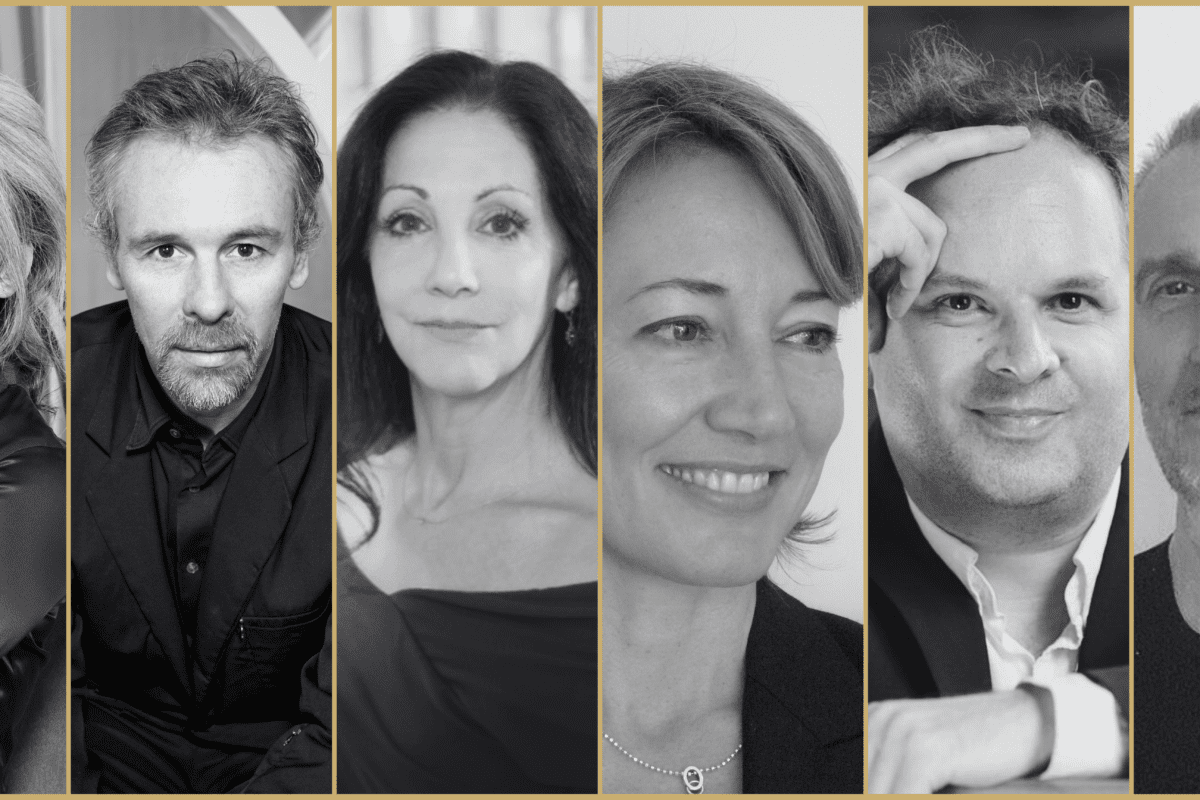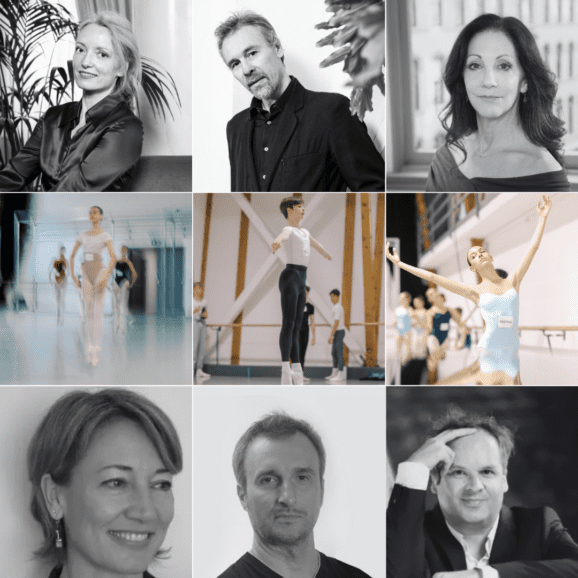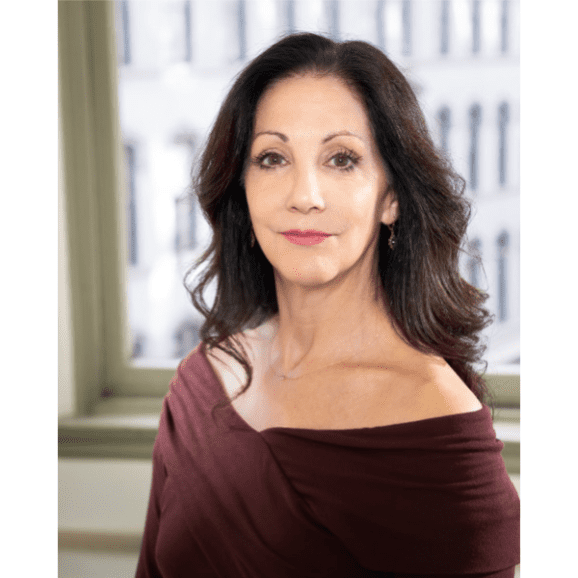Everything began to take shape in the spring of 1972, not on the shores of Lake Léman, but beside a swimming pool in Cannes! Philippe Braunschweig, his wife Elvire, and Rosella Hightower were excitedly discussing their new project, the launch of the first competition for young dancers, scheduled for 1973.
How should it be run? Who should be on the Jury? What criteria would a young hopeful need to fulfil in order to participate?
Enthusiasm was running high and a wealth of creative ideas were emerging. Maurice Béjart and Rosella Hightower had already given their backing: they were prepared to offer Prize Winners of the future competition a grant for training in their respective school, meaning a year’s tuition at the Mudra Brussels, or at the Centre International de Danse in Cannes. However, in order to enhance the credibility of the event, the organisers would need a third serious reference..
Birth of the competition
Accordingly, in the summer of that same year, Philippe Braunschweig went to London to request the support of the Royal Ballet School. His encounter with Michael Wood, director of the prestigious institution, was to prove decisive. “He is the most important man in my life” says Philippe Braunschweig. “Without him, I am not sure the Prix de Lausanne would have been possible”. Anxious to meet representatives from the continental world of dance, Michael Wood agreed to be part of the competition in the making, to provide a grant, and to delegate Barbara Fewster, dance director, as a member of the jury. Philippe Brauschweig’s determination to launch the Prix de Lausanne was strongly influenced by his recent acceptance of the invitation from Manuel Roth – then director of the Théâtre municipal de Lausanne – to become chairman of the Fondation en faveur de l’Art Chorégraphique. His main concern was not only to schedule ballet productions in the Canton de Vaud’s main urban centre, but also to create an event in the service of dance. The first Prix took place as planned, from January 19 to 21, 1973, in the Théâtre municipal de Lausanne. It was a sell-out and Rosella Hightower successfully chaired the jury. Two grants were offered, along with 5,000 francs in cash. The following year, however, things did not run so smoothly: the venue turned out to be small, the jury lacked sufficiently clear selection criteria and spectators became impatient while awaiting the final results. “At that time I had the feeling that we were never going to make it”, recalls Philippe Braunschweig.
By 1975, the event had risen to the challenge: the Prix was beginning to find its pace, to expand and to assert its identity. That year, on the initiative of Marc-Antoine Muret, the competition took place in the Théâtre de Beaulieu. An effective evaluation system was introduced for the jury, which was enlarged from seven to eleven members; and additional prizes were introduced as a complement to the grants (a prize for the best Swiss competitor and a prize for the best personal choreography). Over the following years, the Prix de Lausanne began to establish itself within the world of dance, largely thanks to the rigorous artistic line imposed by the jury and cultivated by Elvire Braunschweig, as well as to the effective organisation demonstrated in planning and running it.
Several innovations were successively adopted. The competition soon found an audience well beyond local and national borders: from 1974 onwards, the Télévision Suisse Romande decided to broadcast the final each year; and in its turn the Japanese television channel NHK began transmitting the event to a large number of fascinated viewers. From then on, the Prix could focus on its main concerns: the need to take account of the diversity of candidates (in terms of training and origin); and to continuously adjust to the evolution of dance. For example, it became apparent that certain dancers demonstrated abilities sufficient to enable them to embark directly upon a professional career. A professional prize was therefore created in 1980. Moreover, it was also clear that the repertory of dance companies was becoming increasingly open towards contemporary forms of expression. As from 1984, a contemporary dance lesson was therefore introduced into the selected rounds. Two years later, in order to give equal chances to candidates from small private schools and those trained in large institutions, a distinction between students was clearly defined and the regulations were modified to ensure that one third of candidates for the semi-final and final should come from private schools.
Renowned choreographers such as John Neumeier and Heinz Spoerli agreed to serve on the jury. The growing recognition gained by the Prix, as well as its excellent reputation, enabled it to organise four prestigious performances: Les enfants de la rue du Théâtre in 1977, under the patronage of Princess Grace de Monaco; as well as gala evenings devoted to Maurice Béjart in 1980, Rosella Hightower in 1982 and John Neumeier in 1984. Princess Caroline de Monaco honoured the 20th edition with her presence and Prince Takamado of Japan attended the 1996 competition as guest of honour. Over the years, the Prix has grown in scale and significance in all areas. The number of candidates has risen with each edition, from thirty in 1973 to about two hundreds years later. From only a handful of schools offering grants the first year, there are now almost thirty.
New York, Tokyo, Moscow and the 25th
We wanted to enhance the international image of the Prix and it was therefore essential to take it abroad.
New York in 1985, Tokyo in 1989 and Moscow in 1995: within ten years, the competition experienced three big foreign trips. Each was based on the same formula, with selected rounds for the semi-final held in Lausanne for European candidates, while the same stages took place in parallel in the host cities.
It all started when Harvey Lichtenstein, director of the Brooklyn Academy of Music, opened the doors of his theatre to the Prix. The New York Times devoted a major feature to the visiting competition from Switzerland, and an enthusiastic audience was there to witness it. There were of course some scary moments, due to the difficulties inherent to logistics in such a huge city, such as the finalist’s coach driver who took an overly long nap and arrived at the Finals in the very nick of time.
In scheduling the Tokyo venue in 1989, Philippe Braunschweig had other goals. He had been making annual visits to Japan since 1956 and had even created a Prix de Lausanne office there with Hiroko Yamada in 1980. Young artists involved in Western-influenced arts such as dance had a very tough time in Japan, and holding the Prix de Lausanne in Tokyo was intended to give the Japanese press an opportunity to highlight this difficult situation. Communication with another civilisation required long preparation on the part of organisers, and Hiroko Yamada devoted two years full time to preparing and staging the event.
Organising the Prix in Moscow closely resembled a “mission impossible”. The legendary Bolshoï Theatre, with its immense stage and great performers, is evocative of the entire history of ballet. Nonetheless, before the collapse of the Berlin Wall, the Prix de Lausanne, as a private institution, was unable to welcome candidates from the Soviet Union. From 1992 onwards, Philippe and Elvire Braunschweig attempted to recreate links with Russian ballet, but the distrust Russian ballet schools felt for the Western world made this an extremely difficult task. In order to convey the message that the Prix de Lausanne had great potential to offer youthful talents from Eastern Europe, it was essential to hold the competition in Moscow and to obtain optimal coverage by the Russian press. During the twelve months prior to the event, a representative travelled to Moscow each month to supervise preparations. The lack of organisational coherence in Russia rendered this mission extremely complex, but it was thanks to the determination of Philippe and Elvire Braunschweig and to the efficiency of Patricia Leroy, Secretary General of the Prix, that the project finally reached fruition. The role of Elvire, who was of Russian origin and perfectly bilingual, was particularly significant. In the end, the consistent efforts and travels paid off and the impossible proved possible after all.
On the occasion of the 25th anniversary of the Prix de Lausanne, which welcomed Rosella Hightower as guest of honour, an international symposium on classical dance was organised: “What future for classical dance?” , based on the statement that classical dance is a living, organic art – very much alive and a powerful, positive presence in the world of professional dance education and performance, and that classical training is an essential ingredient in the maintenance of the highest standards of the performing art of dance.
At the close of the 25th edition, Philippe Braunschweig announced his decision to relinquish the Presidency of the Fondation en faveur de l’Art Chorégraphique and to leave room for a new management team, made up of five members: Franz Blankart, President; Charles Gebhard and Antoine Hoefliger, Vice-Presidents; Patricia Leroy, Secretary General; and Jan Nuyts, Artistic Director.
Development and consolidation
Between 1998 and 2001, the new team laid out the milestones for a development path intended to be increasingly education-oriented and tailored to the needs of future dance professionals. First of all, the determination to foster the dancers’ versatility was clearly confirmed: in order to find their place within the profession, they must be able to master both classical and contemporary forms of expression.
From 1998 onwards, young choreographers were commissioned to create the compulsory contemporary variations. Present in Lausanne during the competition week, they accompany the candidates who are dealing with – often for the very first time – the movement and corporal characteristics inherent in this discipline. As the young dancers adapt to the personal language of each choreographer, they learn to free themselves from the constraints imposed by classical ballet, in particular by taking account of their breathing cycle, of how their weight is spread across their body, and of their relationship to the ground as they approach a new movement. Thanks to these contemporary variations specifically adapted to their age, young artists are confronted with new sensations: these will help them develop their aptitude to react to music with imagination and sensitivity and to reveal their personality through expressing their emotions.
A Contemporary Dance Prize was created in 2000, rewarding a finalist having displayed exceptional potential in this discipline when performing his or her variation during the finals. It consists in a contemporary dance course at a major school and includes travel and accommodation.
That same year, in pursuing its objective of supporting each candidate through a personalised pedagogical approach, the organising team introduced individual coaching for preparing the classical variations: the candidates receive advice from an étoile dancer whose mission is to guide them in blossoming on an artistic level, whereas until then candidates’ teachers had tended to give priority to technical aspects. The aim is for young dancers to transcend the potential difficulties of execution and to offer the audience an artistic projection of their own personality in performing a role from the classical repertoire. The coach helps the participant to understand the meaning of the variation by studying the intention behind the movements, as well as by analysing the steps and the musicality. Since then, in order enable all participants to pursue their learning experience throughout the competition, non-selected candidates have had a chance to take classes and meeting members of the jury to discuss their aptitude to become professional dancers. This is a wonderful opportunity for all of them to make the most of the abundance of competencies gathered in Lausanne during the competition week. The best candidates, whom the jury believe have reached the end of their training, may be awarded an apprentice scholarship that will enable them to undertake a professional internship in one of the international ballet companies partnering the Prix de Lausanne.
Since a career in dance is very short-lived, it is vital that dancers should have the educational foundations that will provide them with the means to approach the second part of their professional lives with confidence. With this in mind, the new team decided that, on the threshold of the 21st century, only the institutions offering the selected young artists the possibility of pursuing and completing their basic education could be part of the network of schools established by the Prix de Lausanne.
To consolidate the holistic approach that distinguishes the Prix de Lausanne from other competitions, a health check – in collaboration with a specialised consultant physician – has been part of the competition registration procedure since the year 2000.
The Prix de Lausanne firmly advocates the principle that in order to be a good dancer, one must be in good physical and mental health. Although the aesthetic canons of classical ballet demand that both male and female dancers be slender, it is vital that the importance given to this criterion should not jeopardise their state of health and have a detrimental influence on their future career.
In 2002, Mavis Staines was appointed Artistic President of the Prix de Lausanne, a position she occupied until 2008.
Since that date, the Finals have been broadcast live on the internet, meaning it could now be viewed from around the world. In order to keep track of the evolution in the requirements governing the profession, a new scoring system was introduced in 2004. Whereas candidates had previously been selected based mainly on their physical and technical skills, the jury was now charged with evaluating young dancers’ global potential to develop their talent. The list of criteria was now to include such factors as: their aptitude to “step out” and assert themselves; the ability to understand and reproduce a wide range of movements; as well as musical and artistic sensibilities.
Viewed from this angle, certain youthful talents who are not yet fully equipped on a technical level, may harbour even greater career potential – if they demonstrate the right intentions or “gestural intelligence” – than candidates showing undeniable technical mastery but lacking comprehension of the very essence of movement. That same year saw the creation of the Networking Forum, enabling non-finalist candidates to take part in an audition class attended by directors of Partner Schools and Companies who might thereby possibly decide to invite or hire some of the participants.
Franz Blankart retired in 2006 and handed over the Presidency of the Foundation to Charles Gebhard. For the 34th edition of the competition, the organising team considerably modified the selection process. Since then, candidates no longer need to come to Lausanne to take part in the first selection phase: they can simply send a video. The competition is now within reach of young talents with great potential who do not necessarily have the means required to travel to Lausanne without any financial help. In 2007, the upper age limit for candidates was raised by one year (18 years and 11 months), which made it possible from the following year onward to divide the candidates into two age groups (15 to 16 and 17 to 18 year-olds). This in turn served to fine-tune the selection criteria according to the level of artistic maturity of the young dancers.
In 2008, Wim Broeckx became Artistic Director of the Prix de Lausanne. Pursuing the idea of making coaching available to as many candidates as possible, the semi-final was dropped from this edition onwards, thereby giving all candidates selected to come to Lausanne a chance to take part in all the rounds performed in front of the jury.
Eager to take part in training future talents on a regional level, the Prix de Lausanne began organising as of 2009 and on behalf of the Leenaards Foundation an annual competition intended for young dancers from French-speaking Switzerland, named Tremplin Danse (Dance Springboard). It offers a young dancer a chance to receive a scholarship enabling him or her to study at a renowned European school partnering the Prix de Lausanne.
The following year, Charles Gebhard retired as President of the Foundation and was succeeded by Beth Krasna.
In 2011, the competition, which is moving towards its fifth decade, launched a new project: a world tour with its star dancers! A series of master classes given by famous artists who are former Prix de Lausanne prize winners takes the philosophy of the competition to the four corners of the earth. The main purpose of this encounter is to facilitate exchanges between potential young participants and former Prize Winners. The latter, in addition to providing advice through dance classes, can also share their vision of the competition, talk about what the experience meant to them, and explain which doors the Prix opened for them as well as the consequences on their career.
A unique experience
The candidates interviewed during the Prix de Lausanne week all testify to the fact that the competition is distinguished by a spirit of interaction rather than competition and by a friendly atmosphere pervaded by a sense of sharing. This results in a timelessly rich atmosphere where dance is the focus of every passion. Driven by a desire to ensure that the Prix de Lausanne continues to be considered the world’s best ballet competition and the one that best integrates educational and health aspects, those in charge of it have set themselves the task of perpetuating the exceptional and privileged nature of this experience which is the starting point for many brilliant careers.
Towards this goal, Wim Broeckx bowed out in 2012, entrusting his duties to a permanent Artistic Director based in Lausanne, Amanda Bennett. Her mission consists of consolidating the Prix’s worldwide network of ballet schools and companies and ensuring that the Prix de Lausanne pursues the role it has been playing for over 40 years as an outstanding international platform for young dancers.
In 2014, Beth Krasna leaves.



